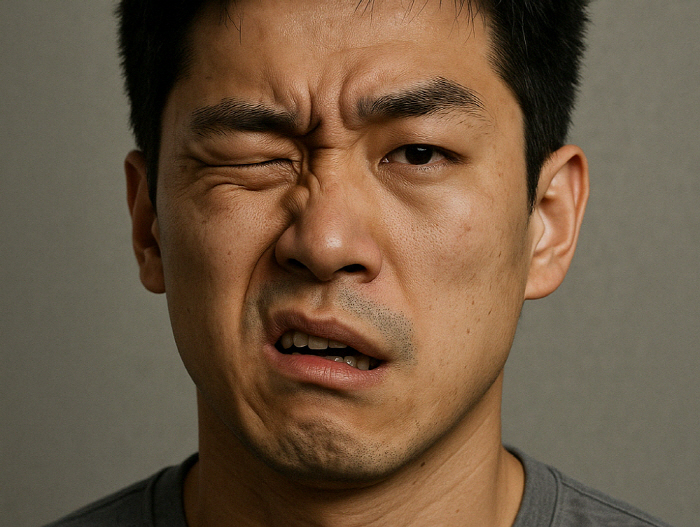Stressful 2040s, beware of facial cramps with trembling eyes and mouth
Apr 22, 2025
|
However, if these symptoms persist even after taking enough magnesium and taking a rest, it is necessary to check whether it is a precursor to facial cramps caused by brain nerve problems.
In particular, it is estimated that facial cramps in the 20s and 40s have increased recently due to accumulated stress in life.
Usually, facial cramps are known to be a disease mainly reported in older patients. However, in fact, looking at relevant data (G514) within the Health Insurance Review and Assessment Service from 2019 to 2023, the average number of patients in their 20s to 40s per year amounts to 47.8% of all patients. In the past five years, nearly half of the patients have been actively engaged in social activities.
Yoon Kang-joon, a neurosurgeon at Gangnam Bedro Hospital, explained, `Facial cramps in young people are likely to be caused by stress stimulation of nerves and blood vessels in the brain. If left as they are, accurate diagnosis and treatment are essential as symptoms are likely to intensify.'
◇Danger such as facial asymmetry and facial paralysis if left unattended
The nerves in the brain are largely divided into 12 and each has its own function. Among them, facial cramps are related to the seventh nerve responsible for controlling facial expression muscles, the 'facial nerve'. When the root point where this facial nerve begins is pressed or stimulated by blood vessels, abnormalities in the contraction and relaxation system of facial muscles occur, resulting in facial spasms around the eyes and mouth as blood vessels beat.
In most cases, it is difficult to accurately determine the cause of this phenomenon. However, repetition of stress and tension is pointed out as a major stimulus factor that puts a burden on the nerves. This is not irrelevant to the high proportion of people in their 20s and 40s who are vulnerable to stress such as work life and social pressure.
CEO Yoon Kang-joon said, `In fact, there was a case of surgery on a 40-year-old office worker who had suffered facial cramps for two years, including tremors under his left eye and corners of his mouthIn this patient, there was no problem with the nerves and blood vessels themselves, but it was determined that the nerve began to be stimulated by the blood vessels due to constant stress, so the operation was performed, and the tremor symptoms disappeared after the operation", he explained.
The problem is that, as mentioned earlier, this is often neglected. Unlike eye tremors due to magnesium deficiency, facial cramps initially start in a local area but gradually progress to other facial areas, so they are more likely to cause inconvenience in life. However, if the symptoms are left unattended for such a long time, not only can facial asymmetry symptoms appear, but also severe facial paralysis, taste and hearing loss. In addition, it is likely to take more time to recover after treatment, so caution is needed.
◇ Face cramps continue to tremble and become tense on one side of the face
One of the ways to distinguish common eye tremors due to facial cramps and magnesium deficiency is to observe whether symptoms appear on both sides of the face. Facial cramps are likely to show symptoms concentrated on one face. When you are nervous or stressed, your symptoms get worse, and it is also a characteristic of facial cramps that symptoms continue while sleeping. Symptoms that persist even after sufficient rest and nutrition are also recommended to suspect facial cramps and seek examination with a neurosurgeon.
The diagnosis of facial cramps is made through MRA brain imaging, which can observe and diagnose nerves and blood vessels. Through this, if it is confirmed that the blood vessels are compressing the cranial nerve, treatment is performed to relieve it. As treatments, non-surgical treatments that suppress motor nerves and prevent muscle contraction through drugs and Botox and surgical treatments that remove the cause of facial cramps themselves are typically implemented. However, in the case of drug treatment and Botox, it may be temporarily helpful, but it is not a fundamental solution, and the treatment effect is difficult to continue.
The main surgery performed for facial cramps is microvascular decompression (MVD)', which physically reduces the distance between blood vessels and cranial nerves to eliminate the cause of facial cramps itself. Usually, if symptoms persist for a long time and it is difficult to treat with non-surgical therapy, surgical therapy is performed. Surgery is mainly performed through local incisions, and in most cases, tremors immediately disappear immediately after surgery, and the success rate of surgery is known to be very high, over 95%.
"Facial cramps caused by stress are not a functional abnormality in the nerves or blood vessels themselves, but a symptom of continuous external stimulation," said CEO Yoon Kang-joon. "Since microvascular decompression is sufficiently curable by separating nerves and blood vessels to remove causative factors, it is better to receive proper treatment quickly through sufficient consultation with an experienced specialist rather than neglecting them or being scared of them."," he said.
|
This article was translated by Naver AI translator.















